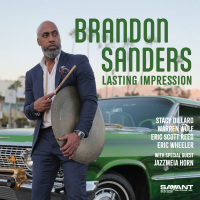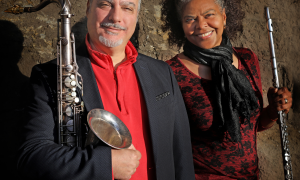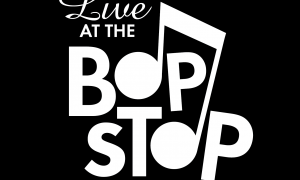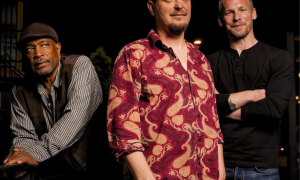Over the past 30 years, Bret has grown close with Sonny Rollins, Joe Lovano, Billy Taylor and other jazz artists, working to document their stories on video and make those clips available on the web. Bret's interviews in 2007 with Orrin Keepnews for Concord Records are prime examples of the medium's rich potential. His upcoming series on Ray Charles should be equally potent.
In Part 2 of my interview with the self-styled “Jazz Video Guy," Bret talks about his professional and personal relationship with Sonny Rollins as well as his upcoming Ray Charles video series:
JazzWax: How did you become involved with Sonny Rollins?
Bret Primack: In 1978 I wrote a profile of Sonny for Down Beat. As part of the article, I took the train up to his house in New York to interview him. His wife Lucille picked me up at the station. I had idolized Sonny for years and knew he wasn't comfortable with interviews. When we pulled up at the house, Sonny was standing at the top of the stairs. He looked 10 feet tall.
JW: Were you nervous?
BP: No. When we began, he wasn't very forthcoming in his answers. But I knew from all of the interviewing I had done that when you ask a question, resist jumping in with questions or comments. Remain quiet, and your subject will likely come up with elaboration.
JW: Did that work with Sonny?
BP: When I'd ask Sonny a question, he'd give me a short answer and then just sit there, without saying anything. At first, I thought the interview wasn't going well. Then I realized that Sonny was thinking. When enough time had passed, he'd talk with greater detail and say something fantastic.
JW: What did you do after the interview?
BP: Sonny, Lucille [pictured] and I had lunch in his kitchen. Then he took me out to a large shed about 50 feet away from his home where he practices. He has since built another one. The original was about 20 feet by 20 feet, with high ceilings, skylights, stacks of LPs, posters from Japan, an old phonograph and basic furniture. It clearly was a place to work, not relax. There was an unbelievable vibe in there. You felt the energy as soon as you walked in. We sat and hung out for a couple of hours. Sonny and I had known each other through pianist Walter Bishop, Jr., but spending time together really cemented the relationship.
JW: Years later you developed Sonny's website and now host it.
BP: In 2006, Sonny's nephew, trombonist Clifton Anderson, and Terri Hinte, Sonny's publicist, called me. They suggested it was time for Sonny to have a web presence for global fans. Clifton also recognized the value of documenting Sonny's legacy on video.
JW: Did you work directly with Sonny on the site?
BP: No, I worked with Clifton
JW: Does Sonny own a computer?
BP: No. I fax him the guest book entries once a week. If there are site changes, I send them to him. He sees the videos from time to time. I remember showing him my Like Sonny video, which featured Sonny's impressions of John Coltrane. When it was over, Sonny got teary and said, “Now you're getting to me."
JW: How has Sonny responded to the website and his YouTube presence?
BP: Sonny is both amused and amazed by the response. The truth is, he has no idea how he's touched so many lives. The site allows his audience to interact with him, and their faxed heartfelt messages are very moving. He usually says to me, “Who knew?"
JW: What is it about Sonny that most people don't know?
BP: Sonny is a great musician but he's also a great friend. He's hugely loyal and is someone you can talk to about personal things. He's a father figure for me, an elder if you will. With Sonny, there's no judgment. His thinking process is involved in everything he says and does. [Pictured: Bret and Sonny looking at a video podcast on an iPhone]
JW: Did you ever confide in Sonny?
BP: When I first came up with the idea to produce video podcasts for record companies, I encountered push back. Executives said, “Why do we need this? Does it have value? Why should we spend the money?" I talked to Sonny about what I was facing. He said, “The truth will always get through. If you do the right thing and believe in it, eventually people will hear it." He was right.
JW: What's your favorite e-mail from a viewer of your Sonny Rollins videos?
BP: Someone recently sent me an e-mail that said, “When I watch these videos, I feel like I'm in Sonny Rollins' living room." That makes me realize how deeply these videos touch people and how intimate the experience is for them.
JW: How did you come up with the name, the Jazz Video Guy?
BP: Two years ago, Damani, my 9-year-old grandson, was watching my jazz videos on YouTube. At some point it dawned on him that that I was the person putting them up there. He said, “Hey, you're the jazz video guy." The name clicked.
JW: What are you working on now?
BP: A video podcast series for Concord Records on the label's re-issue of seven classic Ray Charles albums. Instead of interviewing one person, as I did last time with Orrin Keepnews, I'm interviewing many of the artists who were involved with the different albums. The podcasts will be rolling out later this year. [Photo of Ray Charles in 1966 by Bill Ray for Life]
JW: So what's your mission?
BP: To tell the stories of jazz musicians so that the artists behind the music become humanized. I want old and new fans to see where jazz comes from. In the process, hopefully I'm helping to preserve the legacy of jazz through video. Long after traditional print is gone, people will watch these videos and learn something about the music and how specific recordings were made.
JW: Do you think video is fully appreciated yet?
BP: No, but it's making inroads. Velocity is everything today when it comes to information and communication. Video is the fastest medium for communication, and we're really at the dawn of the short-form age. It's truly an exciting time for video and jazz history.
JazzWax clip: Sonny Rollins is very soft-spoken, humble and almost shy. So when you can hear him in a relaxed interview setting answering questions, it's a treat. Here, Bret asked Sonny in 2006 how he sustains his intensity when playing...
This story appears courtesy of JazzWax by Marc Myers.
Copyright © 2026. All rights reserved.

























